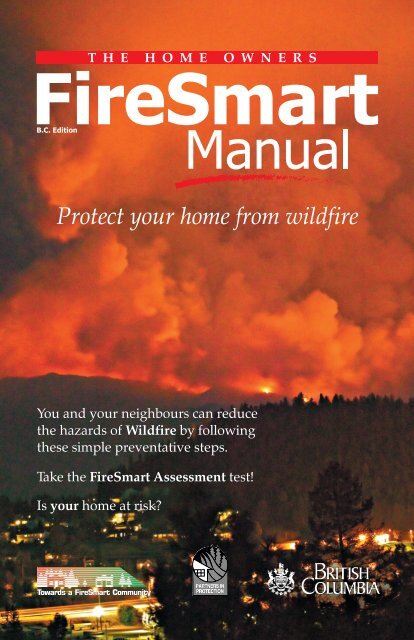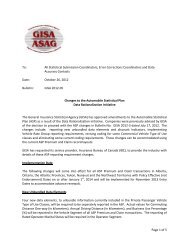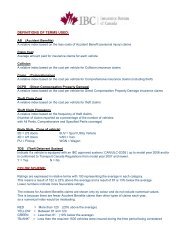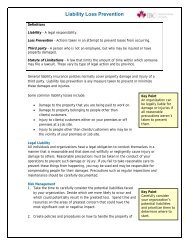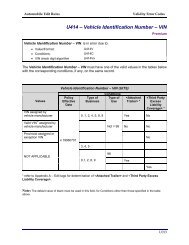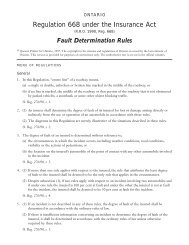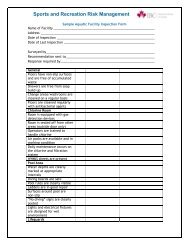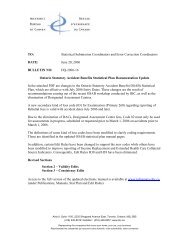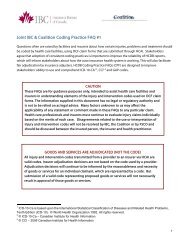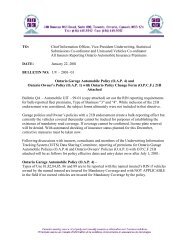The Home Owners FireSmart Manual - BC Edition
The Home Owners FireSmart Manual - BC Edition
The Home Owners FireSmart Manual - BC Edition
Create successful ePaper yourself
Turn your PDF publications into a flip-book with our unique Google optimized e-Paper software.
<strong>The</strong> <strong>BC</strong> Forest Service - Protection Program, would like to thank the following:<br />
• Partners in Protection for providing the information used in this brochure,<br />
• Alberta Sustainable Resource Development - Forest Protection for allowing use of the<br />
<strong>Home</strong> <strong>Owners</strong> <strong>Manual</strong>, Second <strong>Edition</strong> as a model,<br />
• <strong>The</strong> <strong>BC</strong> Office of the Fire Commissioner and Provincial Emergency Program for<br />
their support in producing this publication.<br />
Waiver<br />
<strong>The</strong> British Columbia Ministry of Forests and the Crown accept no responsibility of liability for any<br />
loss or damage that any person may sustain as a result of the information in, or anything done or<br />
omitted pursuant to, this pamphlet.<br />
Cover photo: John Tocher, Kelowna, B.C.<br />
Okanagan Mountain Park fire from West Kelowna Estates - Aug. 19, 2003.
<strong>The</strong> Rural Reality<br />
Wildland forest fires are capable of spreading at an astonishing rate. Crowning<br />
forest fires often spread at up to 5.5 kilometres per hour, with spotting as far<br />
as 2 kilometres ahead. Wind blown grass fires can spread at speeds up to 8.5<br />
kilometres per hour.<br />
In British Columbia, an average 48% of all wildfires are caused by human<br />
activity. Wildfire is also a natural phenomenon. Nearly 52% of British<br />
Columbia’s wildfires are caused by lightning strikes. Over the last several centuries,<br />
large areas of British Columbia have been burned over repeatedly.<br />
Over the last 10 years, on average over 2,500 wildfires were started in British<br />
Columbia each year consuming over 25,000 hectares of forested land annually.<br />
Thousands of families were recently evacuated from their communities and<br />
hundreds of homes destroyed.<br />
If you live in or near a forested region of our province, sooner or later you<br />
may have to contend with the spread of a wildfire. <strong>The</strong> best protection against<br />
loss, damage or injury due to wildfire is prevention.<br />
Following the <strong>FireSmart</strong> <strong>Home</strong> <strong>Owners</strong> <strong>Manual</strong> can help reduce that risk.<br />
PHOTO: <strong>BC</strong> FOREST SERVICE 1
2<br />
Get Ready<br />
Properly preparing your home and community doesn’t guarantee that you<br />
will not incur fire damage, but it does reduce the risks. Obtain insurance<br />
coverage for all property at risk from fire – government disaster financial<br />
assistance is limited and only covers uninsurable perils.<br />
Some of these preventative measures cost very little and reduce fire dangers by<br />
a great deal; others require planning and a long-term commitment to change.<br />
Let’s look at three areas where you can apply <strong>FireSmart</strong> standards to protect<br />
or reduce the damage to your property should a wildfire strike.<br />
Site Preparation<br />
Any kind of vegetation is<br />
combustible.<br />
Mature trees, shrubs, grass, even<br />
your woodpile, are all potential<br />
fuels and can easily ignite (increasing<br />
the chance of building ignition<br />
and loss.) Managing the space<br />
around your house and buildings is<br />
of prime importance.<br />
This diagram shows the<br />
Priority Zones surrounding<br />
an interface building or<br />
group of buildings.<br />
Interface Priority Zones<br />
Do you have a cleared zone around your house<br />
and buildings?<br />
<strong>The</strong> first 10 metres of space around your home<br />
is your “First Priority”. It’s the most critical area<br />
to consider for fire protection. A good fuel free<br />
space gives firefighters a chance to save your<br />
home from an advancing fire. A home without a<br />
good fuel free space around it can make firefighting<br />
difficult, if not impossible.<br />
What to do?<br />
Remove any shrubs, trees, deadfall or woodpiles<br />
from this area and keep your grass mowed and<br />
watered.
How <strong>FireSmart</strong> is your “Second Priority” zone?<br />
From 10 to 30 metres out from your home is the second priority zone. In this<br />
zone, you need to reduce fuels by thinning and pruning so that combustion<br />
cannot be supported.<br />
What to do?<br />
Remove trees and debris that<br />
can spread fire upwards to<br />
become a fast spreading crown<br />
fire. Space trees so that the<br />
crowns of individual trees are<br />
3 - 6 metres apart.<br />
Remove or reduce the number<br />
of evergreen trees in the<br />
area. Evergreens such as pine<br />
and spruce are much more<br />
combustible than deciduous trees. In fact, aspen, poplar and birch all have very<br />
low flammability rates.<br />
Remove deadfall, thick shrubbery and mature trees that might provide the<br />
opportunity for a ground fire to climb up into the forest canopy. Once a fire<br />
crowns out, it’s virtually unstoppable.<br />
Because fires spread more easily up hill, it’s important to extend the second<br />
priority zone precautions further on downhill slopes and on windward exposures.<br />
Can you extend your <strong>FireSmart</strong> maintenance plan to the “Third Priority” zone?<br />
<strong>The</strong> third priority zone begins 30<br />
metres from any structure and<br />
extends to a distance of 100 metres<br />
and beyond. <strong>The</strong> idea here is not to<br />
remove all combustible fuels from the<br />
forest, but to thin the area so fires will<br />
be of low intensity and more easily<br />
extinguished.<br />
What to do?<br />
Thin or reduce shrubs and trees that<br />
make up the under story, retain fire<br />
resistant deciduous trees, space trees<br />
(3 - 6 metres between crowns) to reduce<br />
the potential for a crowning fire.<br />
Low stand density where trees are widely spaced and crowns do<br />
not touch or overlap.<br />
Lawn or non-combustible material<br />
- within 10 metres of building (0 pts).<br />
- within 10 - 30 metres of building (0 pts).<br />
<strong>The</strong>se are…<br />
simple economical steps anyone can take to create a <strong>FireSmart</strong> home, community<br />
or business site. For these actions to be effective, they must be maintained.<br />
3<br />
PHOTO: RICK ARTHUR
4<br />
PHOTO: KELVIN HIRSCH Building Construction<br />
Our second set of <strong>FireSmart</strong> guidelines deals with building materials and<br />
design standards. While it may not be practical or economical to apply all<br />
of them to an existing structure, many <strong>FireSmart</strong> modifications are easily<br />
accomplished. Others can be included in long-term maintenance or renovation<br />
plans or incorporated in new<br />
buildings as they are designed and<br />
constructed.<br />
Is your roof <strong>FireSmart</strong>?<br />
<strong>The</strong> most fire resistant roofing<br />
materials are metal, clay tile and<br />
asphalt shingles. Untreated wooden<br />
shakes and shingles provide no<br />
resistance. <strong>The</strong>y are ideal fuels for<br />
a roaring wildfire.<br />
Ensure that your roof is free of<br />
combustible debris and that no<br />
combustible materials such as<br />
overhanging trees or vegetation<br />
provide fuel for airborne sparks<br />
and embers.<br />
Non-combustible siding (0 pts)<br />
Materials such as stucco, metal siding, brick cement shingles, concrete<br />
block, poured concrete, and rock offer superior fire resistance.<br />
Metal, clay tile, asphalt shingles, or noncombustible<br />
material (0 pts) - the most fire resistant<br />
and remain effective under severe fire exposure.<br />
Unrated wood shakes (30 pts) - provide no fire<br />
protection.<br />
Are your exterior<br />
walls <strong>FireSmart</strong>?<br />
Materials such as stucco,<br />
metal, brick and concrete<br />
offer superior fire<br />
resistance to wildfire.<br />
Logs and heavy timbers<br />
are a little less effective,<br />
while wood and vinyl<br />
siding offer very little<br />
protection.<br />
PHOTO: KELVIN HIRSCH<br />
PHOTO: KELVIN HIRSCH
Is your home vulnerable to firebrand ignitions?<br />
If you are designing your home, try to eliminate areas where airborne sparks<br />
and embers could accumulate and ignite siding, windowsills or trim. Exterior<br />
siding should be fire resistant and extend from ground level to the roofline.<br />
Eaves and vents (on<br />
attics and crawlspaces)<br />
are ready-made openings<br />
that can allow heat and<br />
embers to enter a building<br />
and ignite it. Ensure<br />
eaves are closed in and<br />
screen all vents including<br />
soffits. Keep areas under<br />
decks and porches clear<br />
of debris and sheath<br />
in the undersides of<br />
balconies and decks with<br />
flame resistant materials.<br />
Are your doors and windows<br />
<strong>FireSmart</strong>?<br />
Clear concentrations of fuels within<br />
10 metres of glazed openings. Greater<br />
protection is provided by smaller<br />
double or thermal pane or tempered<br />
glass windows. Single pane glass<br />
provides virtually no protection.<br />
Tempered (0 pts) - optimum protection is<br />
provided by tempered glass.<br />
Closed eaves,<br />
vents screened<br />
with 3-millimetre<br />
mesh and<br />
accessible (0 pts)<br />
PHOTO: PELLA WINDOWS<br />
Closed eaves,<br />
vents not<br />
screened with<br />
3-millimetre<br />
mesh (1 pt)<br />
Single pane (2 or 4 pts)<br />
Open eaves,<br />
vents not<br />
screened (6 pts)<br />
Double pane (1 or 2 pts) - moderate protection<br />
is provided by double or thermal pane windows.<br />
5<br />
PHOTO: KELVIN HIRSCH PHOTOS: DON MORTIMER<br />
PHOTO: PELLA WINDOWS
6<br />
Don’t Be the Cause of a Wildfire<br />
Interface fires often start as small<br />
accidental ignitions. <strong>FireSmart</strong><br />
standards are aimed at helping<br />
interface residents to prevent<br />
interface fires from starting.<br />
<strong>FireSmart</strong> your chimney<br />
Chimneys should be constructed<br />
to meet current British Columbia<br />
building code requirements and<br />
should have approved spark<br />
arrestors.<br />
Power lines and propane tanks<br />
Vegetation should be cleared well<br />
back from power lines, propane tanks<br />
and other fuel supplies.<br />
Emergency facilities<br />
<strong>FireSmart</strong> building sites have<br />
adequate emergency vehicle access,<br />
with an on-site emergency water supply<br />
(pool, pond or tank).<br />
Burn barrels<br />
Burn barrels should be located well<br />
away from buildings and other<br />
combustible items. Burn barrels<br />
should have proper ventilation,<br />
screens and should never be left burning<br />
unattended. For safer disposal,<br />
bring your debris to a landfill site.<br />
Contact utility companies for clearing of vegetation<br />
under overhead electrical installations.<br />
Shovels and rakes<br />
Every home should have shovels, rakes, axes, garden hoses, sprinklers and roof<br />
ladders to assist in suppressing wildfires.<br />
PHOTO: BRIAN MOTTUS
A Well Thought Out<br />
<strong>FireSmart</strong> Protection Plan<br />
G<br />
P<br />
I<br />
F<br />
L<br />
H<br />
Q<br />
D<br />
O<br />
A Prune tree branches to a height of 2 metres or more<br />
B Store fire wood 10 metres or more from the house (avoid downslope location)<br />
C Remove all trees, long grass, shrubs, logs, branches, twigs and needles within 10<br />
metres of house<br />
D Thin trees (with 3 - 6 metres between crowns) for at least 30 metres from the house<br />
E Contact your utility company if trees or branches are not clear of power lines<br />
F Grass within 10 metres of buildings should be mowed and watered<br />
G Address, fire or lot number clearly signed for quick identification by fire service<br />
H Driveway is wide enough to accommodate emergency vehicles<br />
I Try to provide an alternate emergency access route to your property<br />
J Pond or tank with emergency water supply<br />
K A <strong>FireSmart</strong> burning barrel<br />
L Driveway clear of trees to a distance of at least 3 or 4 metres<br />
M Chimney installed to code complete with spark arrestor screens<br />
N All eaves enclosed and screen all vents including soffits<br />
O Undersides of balconies, decks and crawlspaces sheathed in with flame resistant<br />
materials<br />
P Propane tanks located at least 10m from building - clear all vegetation within 3 metres<br />
Q Use only fire retardant roofing rated Class A, B or C and fire resistant exterior siding<br />
R Solid shutters or metal firescreens will provide increased fire protection for windows<br />
and doors<br />
N<br />
A<br />
K<br />
R<br />
M<br />
B<br />
J<br />
C<br />
E<br />
7
8<br />
Do Your Own <strong>Home</strong> and<br />
Site Hazard Assessment<br />
Assign yourself the indicated number of points for each assessment area. <strong>The</strong><br />
fewer points you get, the more prepared your property is to successfully survive<br />
a wildfire. If a question does not apply to your home, score 0.<br />
Will your home survive a wildfire?<br />
PHOTO: CDF
<strong>Home</strong> & Site Hazard Assessment<br />
Important Characteristics Point Your<br />
Factors of Material Rating Score<br />
What kind of roofing If you have asphalt shingles, metal,<br />
material do you have? clay tile or ULC rated shakes 0<br />
If you have<br />
unrated wooden shakes 30<br />
How clean is your roof? No needles, leaves or other<br />
combustible materials 0<br />
A scattering of needles and leaves 2<br />
Clogged gutters and extensive leaf litter 3<br />
What is the exterior of Non-combustible material<br />
your home built out of? stucco, metal siding, brick 0<br />
Logs or heavy timbers 1<br />
Wood, vinyl siding or wood shakes 6<br />
Are your eaves and vents Closed eaves and vents with 3 mm<br />
closed up and screened? wire mesh 0<br />
Closed eaves and vents with no mesh 1<br />
Open eaves, open vents 6<br />
Have you screened in your All decks, balconies and porches are<br />
balcony, deck or porch? screened or sheathed in with fire<br />
resistant material 0<br />
All decks, balconies and porches are<br />
screened or sheathed with<br />
combustible material 2<br />
Decks, balconies and porches are not<br />
screened or sheathed in 6<br />
How fire resistant are your Tempered glass in all doors/windows 0<br />
windows and doors? Double pane glass:<br />
• Small/Medium 1<br />
• Large 2<br />
Single pane glass:<br />
• Small/Medium 2<br />
• Large 4<br />
Where is your woodpile More than 10 metres from any<br />
located? building 0<br />
Less than 10 metres from<br />
any building 6<br />
Is your home set back Building is located on the bottom<br />
from the edge of a slope? or lower portion of a hill. 0<br />
Building located on the mid to<br />
upper portion or crest of a hill 6<br />
9
10<br />
<strong>Home</strong> & Site Hazard Assessment<br />
Important Potential Point Your<br />
Factors Hazards Rating Score<br />
What type of forest Deciduous trees (poplar, birch)<br />
surrounds your home, within 10 metres of buildings 0<br />
and how far away is it? Deciduous trees 10 - 30 metres<br />
from buildings 0<br />
Mixed wood (poplar, birch,<br />
spruce or pine) within 10 metres<br />
of buildings 30<br />
Mixed wood 10 - 30 metres<br />
from buildings 10<br />
Conifers (spruce, pine or fir)<br />
within 10 metres of buildings<br />
• separated 30<br />
• continuous 30<br />
Conifers (spruce, pine or fir)<br />
within 10 - 30 metres of buildings<br />
• separated 10<br />
• continuous 30<br />
What kind of vegetation Well watered lawn or non-<br />
grows in the zone combustible landscaping material 0<br />
around your buildings? Uncut wild grass or shrubs<br />
• within 10 metres of buildings 30<br />
• within 10 - 30 metres of buildings 5<br />
Dead and down woody material<br />
within 10 metres of buildings<br />
• scattered 30<br />
• abundant 30<br />
Dead and down woody material<br />
within 10 - 30 metres of buildings<br />
• scattered 5<br />
• abundant 30<br />
Are there abundant None within 10 - 30 metres 0<br />
underbrush and ladder Scattered<br />
fuels in the surrounding • within 10 - 30 metres of buildings 5<br />
forest? Abundant<br />
• within 10 - 30 metres of buildings 10<br />
<strong>The</strong> Wildfire Hazard Level for your home is: Total Score<br />
Low 35 points
Other <strong>FireSmart</strong> Considerations<br />
Important Factors Yes No<br />
Do you have adequate insurance on your<br />
home and property?<br />
Do you have the necessary fire<br />
suppression equipment (shovels, rakes,<br />
buckets, hoses, etc.) easily accessible?<br />
Are your burn barrels screened and at least<br />
10 metres from combustibles and buildings?<br />
Are overhead powerlines clear of<br />
vegetation and at least a tree’s height<br />
away from nearest forest?<br />
Are propane tanks clear of vegetation<br />
and at least 10 metres from dwellings<br />
and other buildings?<br />
Are emergency fire services within a 10<br />
minute drive from your home?<br />
Is your chimney safe?<br />
Is your chimney clean?<br />
Does it have proper clearances and stack heights<br />
with proper screens and fire arresters?<br />
Do you have good access to your property for<br />
emergency response vehicles?<br />
Is the area within 10 metres of your home and other<br />
buildings free of trees, flammable vegetation and<br />
other combusibles?<br />
Do you have an adequate municipal or<br />
on site water supply in case of fire?<br />
Does your family have an emergency<br />
fire and evacuation plan?<br />
11
12<br />
Emergency Phone Numbers<br />
Find and copy down the emergency numbers for your area and keep them in<br />
a visible area close to your telephone.<br />
Fire Department: ___________________________<br />
Police: ___________________________<br />
British Columbia Forest Service<br />
Local Fire Centre: ___________________________<br />
To report a forest fire call:<br />
1-800-663-5555 or *5555 on your cell phone<br />
Property Identification:<br />
Section ______ Township______ Range ______ Other ___________________<br />
Or<br />
Lot ______ Blk ______ Plan______ Other ______________________________<br />
Or<br />
Street Address _____________________________________________________<br />
For more information about protecting your home and community from<br />
wildfire, order a detailed copy of “<strong>FireSmart</strong> – Protecting Your Community<br />
from Wildfire”. Copies available from Partners in Protection, phone (780) 435-<br />
7283 or http://www.partnersinprotection.ab.ca/downloads/index.shtml or from<br />
the British Columbia Ministry of Forests, Forest Protection Branch office.<br />
For more information on fire prevention, detection and suppression<br />
and burning or travel restrictions, contact our website:<br />
http://www.for.gov.bc.ca/protect/<br />
Wildfire Information Line:<br />
1-888-3FOREST or 1-888-336-7378
For more information on the B.C. Forest Service Protection Program,<br />
contact the office nearest you:<br />
B.C. Forest Service, Protection Branch Kamloops Fire Centre<br />
2957 Jutland Road, 2 nd floor 4000 Airport Road<br />
P.O. Box 9502, Stn Prov Govt Kamloops, B.C. V2B 7X2<br />
Victoria, B.C. V9W 9C1 (250) 554-5500<br />
Coastal Fire Centre Southeast Fire Centre<br />
665 Allsbrook Road 208 Hughes Road<br />
Parksville, B.C. V9P 2T3 Castlegar, B.C. V1N 4M5<br />
(250) 951-4222 (250) 365-4040<br />
Northwest Fire Centre Cariboo Fire Centre<br />
Bag 5000 Airport Road 3020 Airport Road<br />
Smithers, B.C. V0G 2N0 Williams Lake, B.C. V2G 5M1<br />
(250) 847-6600 (250) 989-2600<br />
Prince George Fire Centre<br />
1011 4 th Avenue<br />
Prince George, B.C. V2L 3H9<br />
(250) 565-6124<br />
BE FIRE SMART!<br />
Back cover photo: Steve Grimaldi, <strong>BC</strong> Forest Service
To report<br />
a forest<br />
fire call:<br />
1-800-663-5555 or<br />
*5555 on your cell phone


